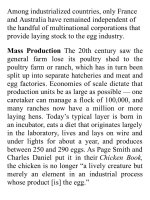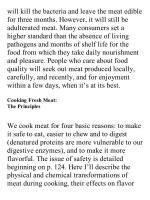On food and cooking the science and lore of the kitchen ( PDFDrive ) 73
Bạn đang xem bản rút gọn của tài liệu. Xem và tải ngay bản đầy đủ của tài liệu tại đây (165.94 KB, 2 trang )
asthefinaltextureofthebutter.Theproperly
aged cream is then warmed a few degrees
Fahrenheitandchurned.
Churning Churning is accomplished by a
variety of mechanical devices that may take
15minutesorafewsecondstodamagethefat
globulesandformtheinitialgrainsofbutter.
The fat crystals formed during aging distort
and weaken the globule membranes so that
they rupture easily. When damaged globules
collide with each other, the liquid portion of
their fat flows together to make a continuous
mass,andthesegrowaschurningcontinues.
WorkingOncechurninggeneratesthedesired
sizeofbuttergrains,oftenthesizeofawheat
seed,thewaterphaseofthecreamisdrained
off.Thisistheoriginalbuttermilk,richinfree
globule membrane material and with about
0.5% fat (p. 50). The solid butter grains may
be washed with cold water to remove the
buttermilk on their surfaces. The grains are
then “worked,” or kneaded together to
consolidate the semisolid fat phase and to
breakuptheembeddedpocketsofbuttermilk
(or water) into droplets around 10
micrometersindiameter,oraboutthesizeof
a large fat globule. Cows that get little fresh
pasturage and its orange carotene pigments
produce pale milk fat; the butter maker can
compensate for this by adding a dye such as
annatto (p. 423) or pure carotene during the
working. If the butter is to be salted, either
fine granular salt or a strong brine goes in at
this stage as well. The butter is then stored,
blended, or immediately shaped and
packaged.
Kinds of Butter Butter is made in several
distinct styles, each with its own particular
qualities. It’s necessary to read labels
carefully to learn whether a given brand has
been made with plain cream, fermented
cream, or cream flavored to taste like









